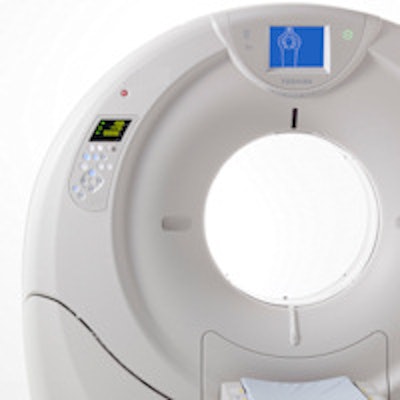
Pseudolesions can easily be misread as true lesions on CT, and to prevent unnecessary investigations, it's essential for everybody -- particularly trainees -- to become more aware about how to spot them, noted the most viewed e-poster presented at the 2013 European Society of Gastrointestinal and Abdominal Radiology (ESGAR) congress in Barcelona.
Under the highly original title of "Psome Psneaky Pseudolesions," radiologists from Leeds, U.K., gave extensive details about various common pseudolesions with the aim of increasing awareness of these findings. More than 400 ESGAR delegates read the poster and gave it a rating of 8.64 out of 10, and the lead authors -- Dr. Elen Mary Thomson, a specialist radiology registrar at the Leeds Teaching Hospitals National Health Service (NHS) Trust in Leeds, U.K., and fellow radiology registrar Dr. Tom Kaye, also from Leeds Teaching Hospitals -- received a Magna Cum Laude for their efforts.
"Look out for Mr. Psneaky!" they warned. "Pseudolesions are commonly encountered on CT examinations and may be due to normal anatomical variants or imaging artifacts."
"Many pseudolesions exist. It is important to recognize pseudolesions in order to prevent unnecessary further potentially invasive investigations. An increased awareness of pseudolesions amongst radiologists, particularly those in training, will help avoid unnecessary interventions or follow-up imaging," they continued.
There are four categories of pseudolesions: vascular, hepatic, gastrointestinal tract, and abdominal.
The vascular type includes pseudolipoma of the inferior vena cava (IVC), pseudothrombus of the IVC, pseudothrombus of the portal vein, and cavernous transformation of the portal vein. The IVC often narrows and has a sharp angle as it passes through the diaphragm; partial voluming of juxtacaval fat is a well-recognized and common pseudolesion, and occurs more commonly in patients with cirrhosis where a shrunken liver causes more severe angulation of the IVC and increased volume of adjacent fat, according to Thomson, Kaye, and colleagues.
"True thrombus of the IVC can occur, usually in the lower IVC and iliacs, and in patients with conditions predisposing to thrombus formation. Collateral vessels within the abdomen and abdominal wall, vessel expansion, and edema indicative of venous impairment will help diagnose true thrombus," they wrote.
Among their other key learning points were:
The renal veins emptying into the IVC are a frequent location for this mixing artifact to occur. Opacified and unopacified blood will often run in parallel. In uncertain cases, delayed imaging will show complete IVC filling as blood returning from the lower extremities will also be opacified.
Similar to that seen in the IVC, partial volume artifact can create pseudothrombi in the portal vein, particularly when there is a relatively horizontal course. Careful evaluation of reformats or the use of thin sections through the area of concern will lead to the correct diagnosis.
Cavernous transformation of the portal vein can cause confusion when structures such as the common bile duct pass within collateral vessels. Careful review of the course of filling defects and evaluation of the normal course of the portal and splenic veins should allow for correct diagnosis.
Compression of the liver by adjacent structures often occurs transiently during deep inspiration, and therefore is often visualized during breath-hold imaging such as CT. The compression results in transient reduced blood flow with the compressed tissue relatively less enhanced and can be mistaken for a true lesion. Visualizing the compressing structure allows for correct diagnosis. Similar lesions are seen from rib compression.
The vein of Sappey is part of the epigastric-paraumbilical venous system draining the abdominal wall into the liver. In the case of superior vena cava obstruction, the vein acts as collateral circulation to allow drainage of the upper limbs, head, and neck. Therefore, contrast injected into the upper limbs will drain via this route and be seen as high density in the liver, and this should not be confused with an arterial liver lesion.
Focal fatty infiltration is of low density, often geometric in shape (no mass effect), and typically occurs adjacent to the falciform ligament. It is likely due to variant venous inflow from the stomach, but the etiology is not certain. If there is uncertainty, then MRI will confirm the diagnosis.
Fatty infiltration is known to occur in several patterns, leading to pitfalls in imaging diagnosis. This particular pattern of multifocal nodular fatty infiltration is uncommon and easily mistaken for metastatic disease, and the underlying pathophysiology is not known. Liver MRI confirms the diagnosis and can avoid the need for biopsy.
Take care when describing gastric mass lesions. Stomach contents can be very heterogeneous and often mimic mass lesions. Clear separation from the gastric wall, lack of adjacent pathology (lymph nodes) and appropriateness to the presenting complaint are paramount.
Colonic wall thickening is often encountered in patients with portal hypertension (usually with cirrhosis) and is secondary to venous congestion. The right colon is usually preferentially affected. The presence of other indicators of portal hypertension clinches the diagnosis.
Injectable materials such as collagen and silicone may mimic pathology and require careful correlation with the patient's history. Similar lesions may be seen in the peri-urethral region when injected bulking materials are used for urinary incontinence. Recognition of these findings may save the patient from unnecessary biopsy or additional treatments.
Gastric diverticula are well-recognized pseudolesions, and correct diagnosis in oncology patients is key in cases where metastasis may upstage a patient. Fluid or gas contents, demonstration of connection to the stomach lumen, and reconstruction of images to demonstrate separateness from the adrenal gland all help with the correct diagnosis.
A very common finding on CT is a splenunculus, which is an incidental, insignificant finding resulting from failure of fusion of the spleen during embryogenesis. Usually small and well defined, it will follow the enhancement pattern of the spleen in all phases of CT or MRI. It is usually found near the spleen, but can be found it unusual locations.
A common anatomical variant is lateral extension of the left lobe of the liver. Careful evaluation of images will enable the correct anatomy to be determined and prevent unnecessary intervention in the case of trauma where the thin, left lobe may be mistaken for subcapsular hematoma or the fat plane between the two may be mistaken for laceration.
The spleen can have a very odd heterogeneous appearance on the arterial phase of imaging. Care should be taken to ensure that imaging is truly in the portal venous phase (look for contrast in the hepatic veins) before calling a splenic lesion. Heart failure and such conditions can delay the timing to achieve the true portal venous phase, the authors concluded.



















